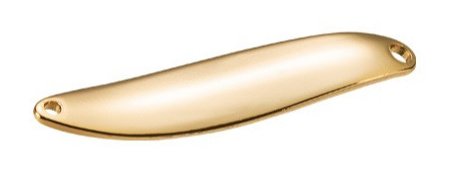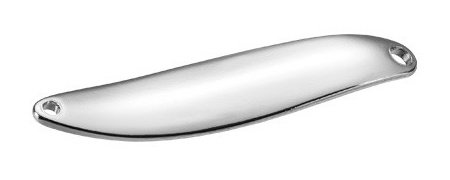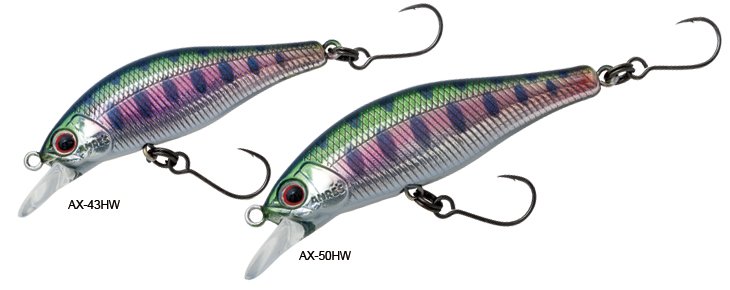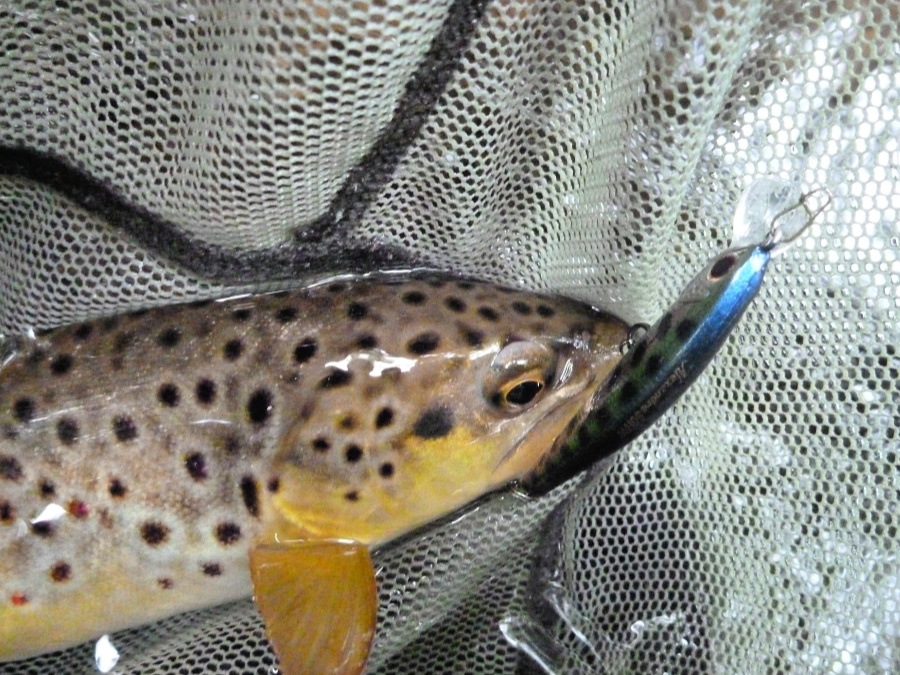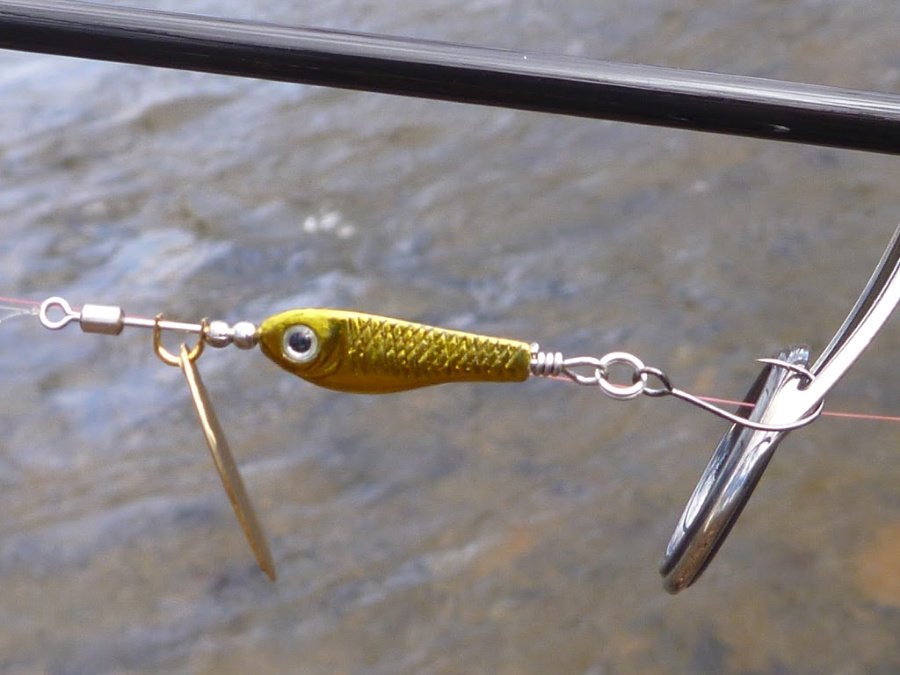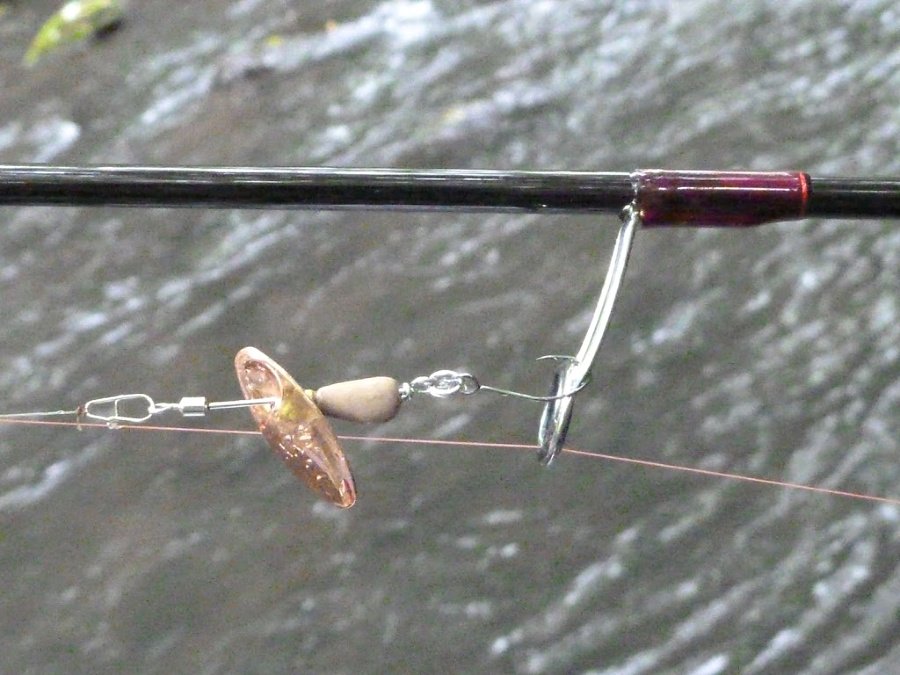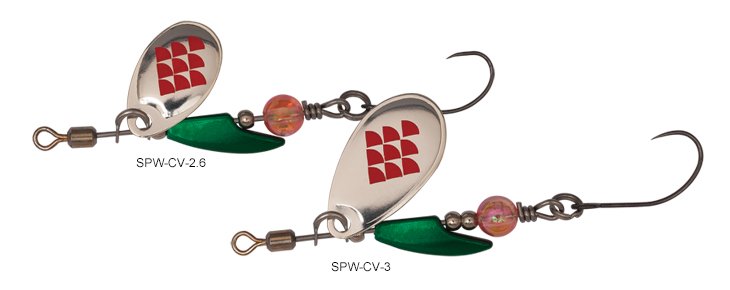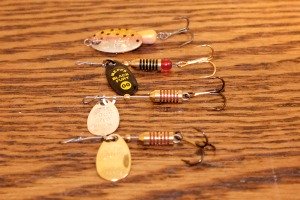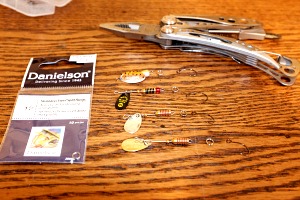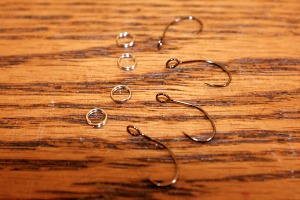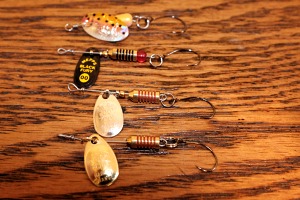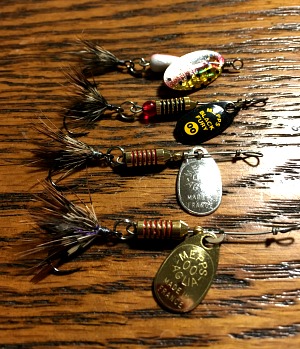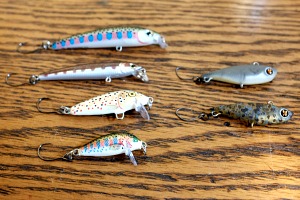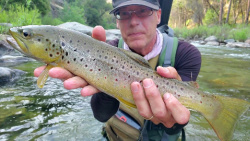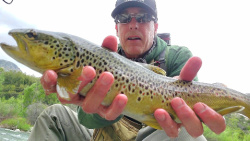Tariffs and Shipping Delays
All items that are in stock, listed to the right, are in the USA and are not subject to tariffs or shipping delays. If you want premium trout rods, they're here now.
Single Hook Lures for Trout
Single hook lures for trout just make sense. Most trout anglers release their catch but releasing a fish doesn't guarantee its survival. Scientific studies have shown that spin fishing causes slightly greater post-release mortality than fly fishing. I am sure the type of rod and reel have nothing to do with it. It's the treble hooks that are the problem. Treble hooks cause more damage and take longer to remove than single hooks. The longer a trout is out of water the greater the chance it will die after release - even if it looks fine swimming away. Single hook lures save trout (or so I thought *).
Lures with barbless single hooks are better yet. They often come out by themselves in the net, making the release very quick and easy. Until you get the fish into the net, though, they hold very well (for fish over about 7" - I cannot keep the 5-6" fish from wriggling off single barbless hooks).
If you plan to keep your catch, and if treble hooks are legal where you are fishing, then of course there's no need to go to a single hook - that is, as long as you can be sure you won't catch any fish that are too small to keep!
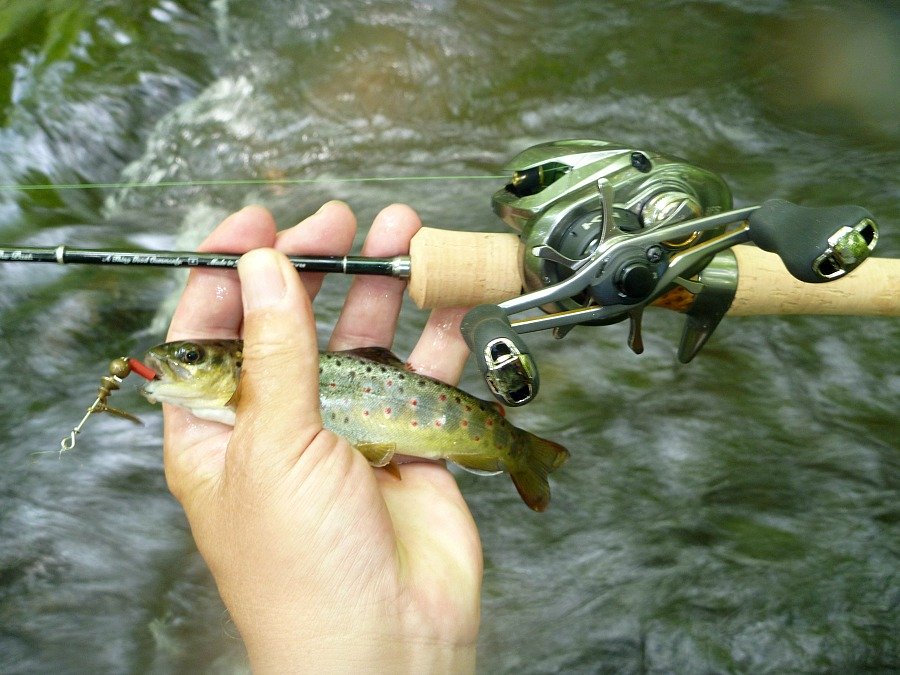 Small fish, all three hook points embedded
Small fish, all three hook points embeddedAfter decades as a fly fisherman, I started spin fishing for trout again just a few years ago and also started fishing with an ultralight baitcaster. At first, I used the lures I still had from years and years ago - all of which of course had treble hooks. One of the first fish I caught on my new baitcaster was this little wild brown trout. It had to be wild because New York state doesn't stock fish that small.
Somehow it managed to get all three of the hook points stuck in its mouth. I eventually got the hook out but I probably killed the fish in the process. Even though it swam away, I was pretty sure it had been out of the water too long. I thought it might die, but I couldn't keep it because it was too short to be legal. I decided right then to fish single hooks instead of trebles!
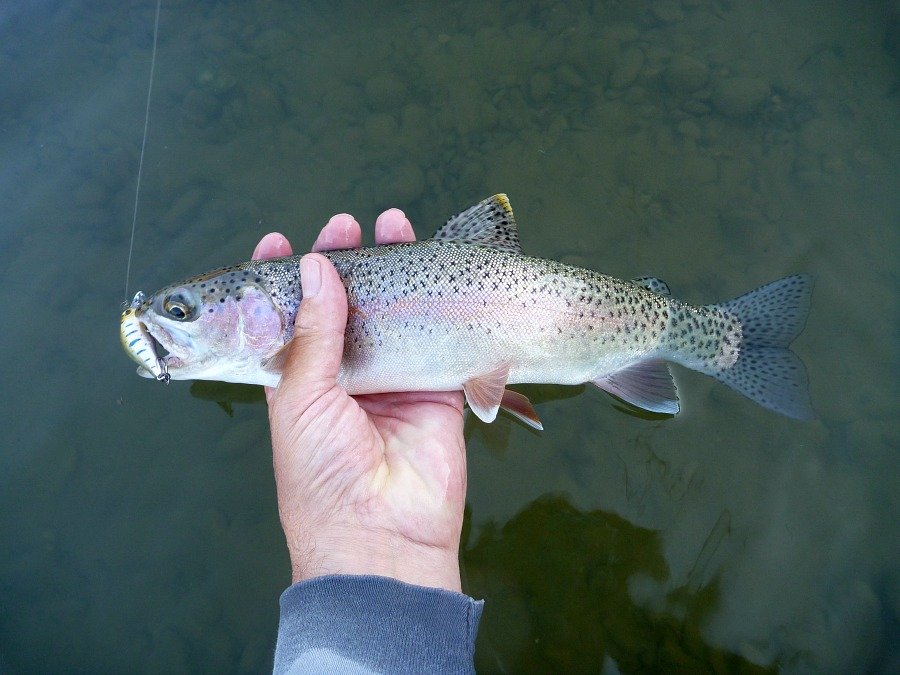 Two points from each hook firmly embedded - very hard to unhook
Two points from each hook firmly embedded - very hard to unhookWell, just like a New Year's resolution, that decision lasted a while (but only a while). A few months later I was fishing in Montana and had some new Japanese plugs I wanted to try out. They worked very nicely - maybe too nicely. Like most of the minnow-shaped lures in the US, they had two sets of treble hooks. The rainbow in the photo above managed to get four out of the six hook points - two from each hook - firmly embedded in its mouth. I thought I'd never get the hooks out. I probably killed that fish, too, but I was staying in a motel and had no way to cook it. I released it and hoped for the best.
I think I should start calling them "trouble hooks."
Right then I renewed my resolve, and that time the resolution held!
Since then, I have made it a point to find and import single hook lures for trout, and single barbless replacement hooks for spoons and plugs. Single hook lures are not at all common here in the US, but they do exist in Japan, mostly for fishing in "Areas." Areas are managed, stocked, pay-to-fish lakes, although some Areas also have pay-to-fish streams.
Pay-to-fish places are not that popular in the US, but they are quite popular in Japan. The ones I know of here are run very differently than the ones in Japan. Here, as far as I know, you pay for the fish. You are expected to keep (and pay for) every fish you catch. In Japan, as I understand it, you pay for the privilege of fishing, but you must release the fish. "Areas" prohibit treble hooks because they do too much damage to the fish. "Lip rippers" are NOT welcome in the Areas!
On this year's (2025) Maine vacation, on which a friend and I always target smallmouth bass, a more compelling reason to fish with single hooks (ideally barbless) rather than trebles became (I hesitate to say) painfully obvious. My friend was unhooking a bass, which he had caught on a plug that had two sets of barbed treble hooks. The bass flipped and slipped out of his hand, firmly embedding two hooks of the other treble firmly in his finger - past the barbs, all the way to the hook bends. With a flopping bass still attached to the first treble hook, you can imagine how painful that was.
I have seen videos demonstrating a quick way to remove a hook, but it involves pressing straight down on the hook shank so that the barb does not catch flesh as you use some line or cord to jerk the hook back out. You can't do that with two hooks that are at a 120 degree angle to each other. It took a trip to the Emergency Room to get the hooks removed. Removing a barbless treble hook would have been easy. Removing a barbless single hook would have been even easier and much less painful.
Single Hook Lures - Jigs
Jigs are probably the simplest single hook lures that you can cast easily with an ultralight spinning rod or an ultralight baitcaster. Although jigs are generally associated with bass or panfish in the US, they have a following among trout anglers as well. Simple marabou jigs have caught trout for years and years. Jig heads and small plastics are more recent, and are just as effective.
There is no question that small jigs and plastics work for trout. I've had trout grab them near the end of the retrieve, with only a few feet of line still beyond the rod tip - and then start jumping! As exciting as that is, I have found that spoons and plugs elicit an even more dramatic response. When fishing a pool that has more than a few trout in it, it is not unusual for several to race each other to get to the lure first. I don't know if it is the flash or the action or a combination of both, but something about spoons, spinners and plugs draws strikes from fish that have ignored a jig and plastic.
In New York, it is illegal to sell lead jig heads that weigh less than 1/2 ounce. A 1/2 ounce jig head is most certainly not finesse fishing, so Finesse Fishing doesn't sell jig heads.
Single Hook Lures - Spoons
Shimano Slim Swimmer spoons come with single barbless hooks.
Areas require single hook lures, mostly single hook spoons or plugs that might have a single hook or a pair of single hooks. The hooks on lures that are designed specifically for Areas are all barbless. The Shimano Slim Swimmer spoons work as well in streams for wild trout as in Areas for stocked trout. They have barbless hooks and come in 1.5g, 2.5g 3.5g and 5g weights.
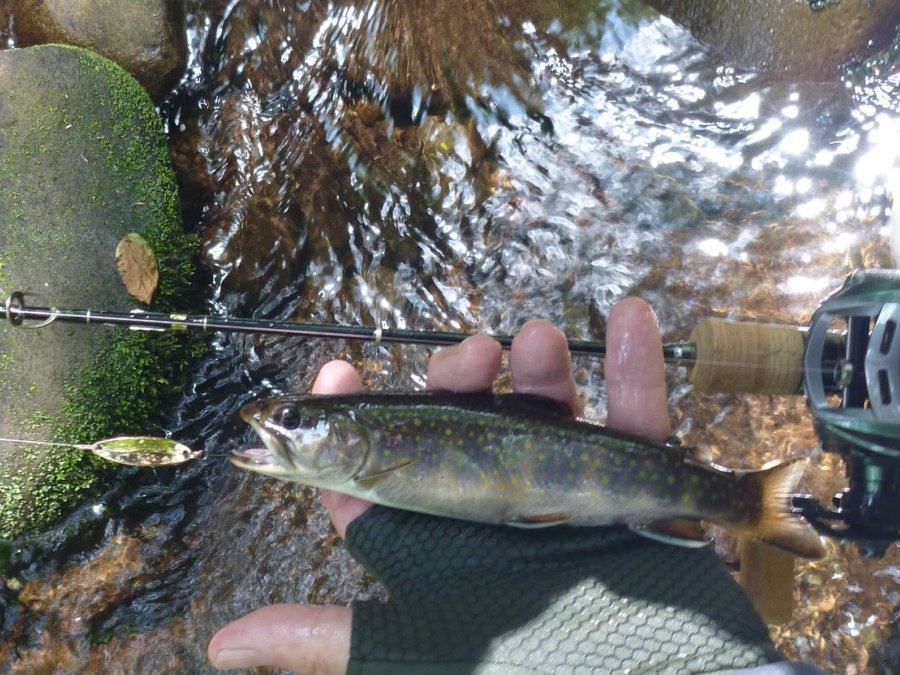 Shimano slim swimmer 2.5g fooled this brookie
Shimano slim swimmer 2.5g fooled this brookieAlthough in Japan spoons are used primarily in the Areas, I have done very well using spoons in streams.
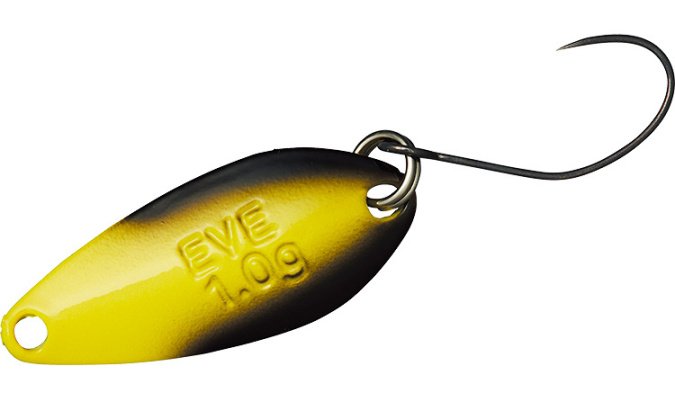 Daiwa Presso Eve - Yellow Dagger
Daiwa Presso Eve - Yellow Dagger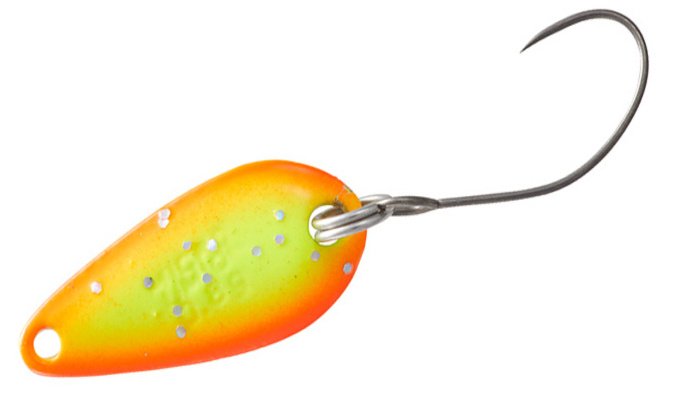 Daiwa Micro Lumion - Orange Mango
Daiwa Micro Lumion - Orange MangoMicro spoons are the most popular lures for fishing Areas. Most are small, smaller than the spoons that are available in the US. Some are very small. The Daiwa Micro Lumion, above, is only 3/4" long.
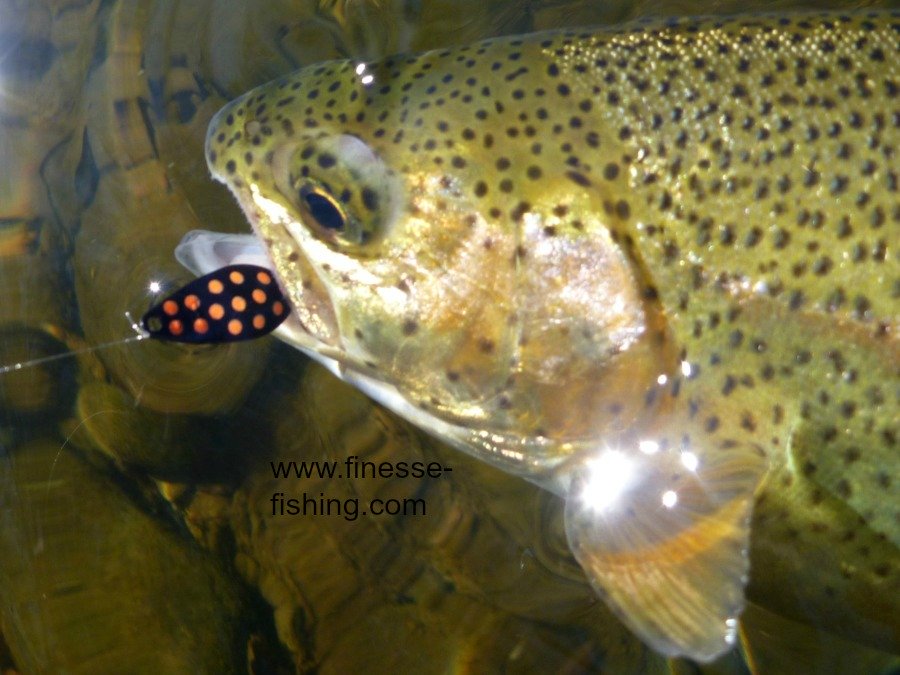 Rainbow trout caught with .8g (1/35 oz) spoon
Rainbow trout caught with .8g (1/35 oz) spoonThe Tenryu Alter RZA612-LT is rated for lures that weigh down to "almost zero." Small, light, single hook spoons cast nicely with the Alter and they do catch fish!
I have been fishing these single hook spoons for a few years now, and I am
very impressed with them. Fish smash them. I've seen fish chase them
for at least 15 feet before catching them. I've seen three or four fish
go after the spoon at the same time. I've seen fish miss the spoon because of the wobble and come back again and again until they got hooked.
Single hook lures hold quite well. Sure, some fish come unhooked, but I think that is because the hook caught just a little bit of skin rather than catching well in the mouth. When a fish is solidly hooked - it's hooked. The single hook spoons don't come out with jumps or head shakes or runs.
However, small trout - the 5-7 inchers - just will not stay on a barbless hook. At least, they won't for me. They wriggle way to much and they wriggle their way off the hook. Largely for that reason, I added single barbed replacement hooks to the shop. The barbs are small and do not cause much tissue damage when you remove the hook. If you are fishing in an area that requires barbless hooks, the barbs are easy to bend down.
There is a huge movement toward barbless hooks, which I support, but I also recognize that scientific studies have shown that the use of barbless hooks does not significantly reduce post-release mortality.** Follow your conscience.
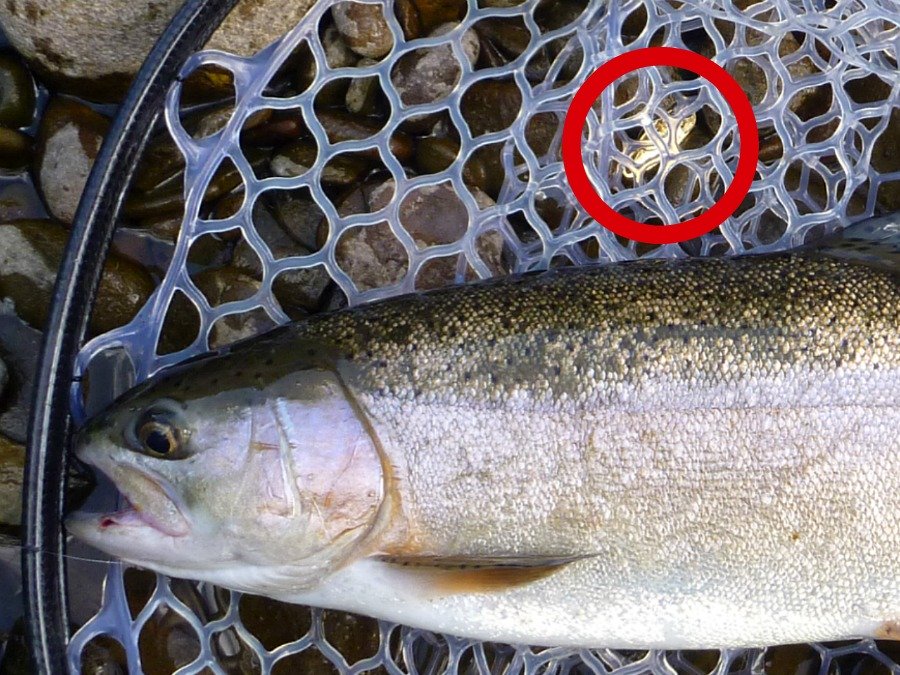 Spoon with single barbless hook came out by itself after the fish was netted.
Spoon with single barbless hook came out by itself after the fish was netted.When fishing larger spoons for larger trout, I remove the barbed factory hooks and put on replacement single barbless hooks (C'ultiva SBL-35 hooks). With the replacement barbless hooks, the spoon often comes out by itself when you get the fish in the net. Releasing a fish couldn't be easier or quicker.
Single Hook Lures - Plugs
Minnow-shaped plugs are excellent trout lures. My focus at Finesse-Fishing.com is on stream fishing more than lake fishing, but nearly all the Japanese plugs I've seen that are designed for use in streams come with treble hooks. The only exceptions I've fished with to date are from Palms, although Shimano now has single hook minnow lures which I have not yet seen (although I intend to correct that as soon as possible).
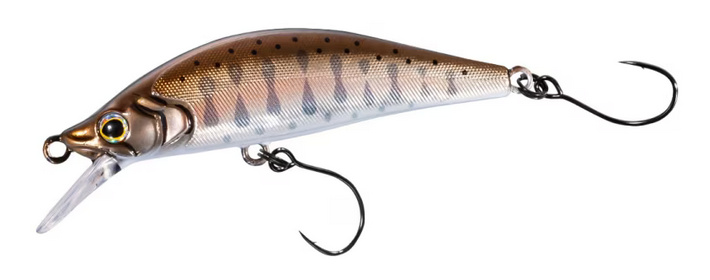 New Shimano Cardiff Refrain 50HS (above)
New Shimano Cardiff Refrain 50HS (above)I'm very impressed with the Palms Alexandra. I've only had a chance to fish it a few times, but it drew strikes well and held fish well despite having barbless hooks.
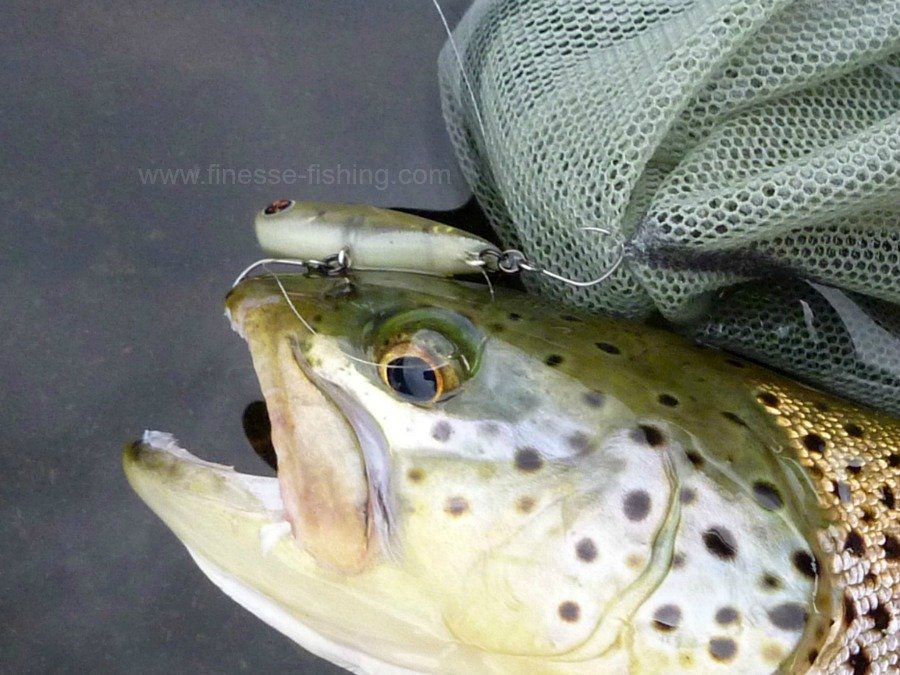 Barbless hooks come out of the net easily
Barbless hooks come out of the net easilyI have not yet fished with a Daiwa Dr. Minnow Area Tune floating minnow lure (shown below) but I have high hopes for this lure. Daiwa sinking minnows have done well for me but they come with treble hooks. This floating minnow comes with barbless single hooks!
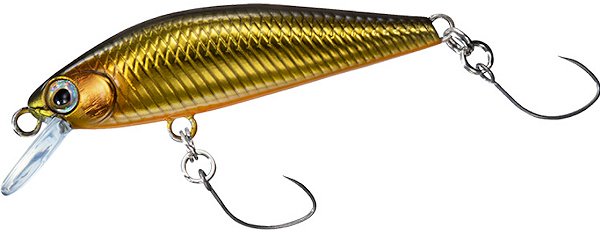 Daiwa Dr. Minnow Area Tune Gold
Daiwa Dr. Minnow Area Tune GoldSingle Hook Lures - Spinners
So far I have found only a few JDM single hook spinners. Luckily, the ones I have found also have built-in swivels and cause relatively little line twist.
I had been curious why Japanese trout anglers rarely use spinners. They generally use micro spoons for stocked fish in lakes and minnow plugs for wild fish in rivers. On a trip to Japan I learned the reason. Two different anglers told me the same thing: spinners are too easy. They said Japanese anglers want more of a challenge. They prefer to impart action to the spoon or plug by twitching the rod tip. Learning just what action the fish want that day is part of the challenge.
That said, there a few Japanese spinners, (and the ones I've used are very good indeed). Also, there are a few Japanese YouTube videos showing spinner fishing for trout in mountain streams.
The Smith Niakis spinner was recommended to me by an angler who has fished all over the world. He said that he didn't understand why I didn't stock the Smith Niakis spinner. I replied that I had a bias against spinners because they cause line twist. He said the Niakis doesn't. In his words they "genuinely don't twist line and are lethal on panfish, bass, trout you name it. Clever design, built in power swivel and offset bodies. These Smith spinners are the real deal, fished them lots on mono, no line twist."
Smith also makes the AR-S single hook spinner. I've found it to be extremely effective, particularly in smaller streams, and it did not cause a problem with line twist. Like the Niakis, it has three features I really like in a spinner: 1) it comes from the factory with a single hook, 2.) the hook is attached with a split ring, so you can change it if you wish (I replaced the factory barbless hook with a minibarb hook on the one above because I was fishing a stream full of 5-7 inch trout), and 3) the built in swivel really does reduce line twist.
In addition to their sinking minnow lure that comes with single hooks, Palms has spinners that come with single hooks. I have done very well with the Palms Spinwalk Clevis spinners (above), which comes with a blade similar to the familiar Mepps spinners.
As with the Smith spinners, the Palms Spinwalk Clevis comes with a
built-in swivel and a single hook attached with a split ring.
Conehead Buggers and Beadhead Keepers
They're not lures. They're flies. However, they should be fished with ultralight spinning rods, not fly rods. Read on and see if you agree.
Replacement Single Barbless Hooks
When I carried Daiwa Silver Creek sinking minnows and Silver Creek spinners, both of which come with treble hooks, I sold replacement single barbless hooks so that customers could switch from trebles to single hooks.
Mepps and Panther Martin both make single hook spinners, but the hooks are nowhere near as good as the Presso Speed hooks or even the C'ultiva hooks. Neither of the companies attaches the hook with a split ring, so you would have to cut the hook (no great loss) and install a split ring before attaching the replacement hook of your choice. Easier to buy spinners that attach the hook with split rings, or better yet, come from the factory with high quality single hooks.
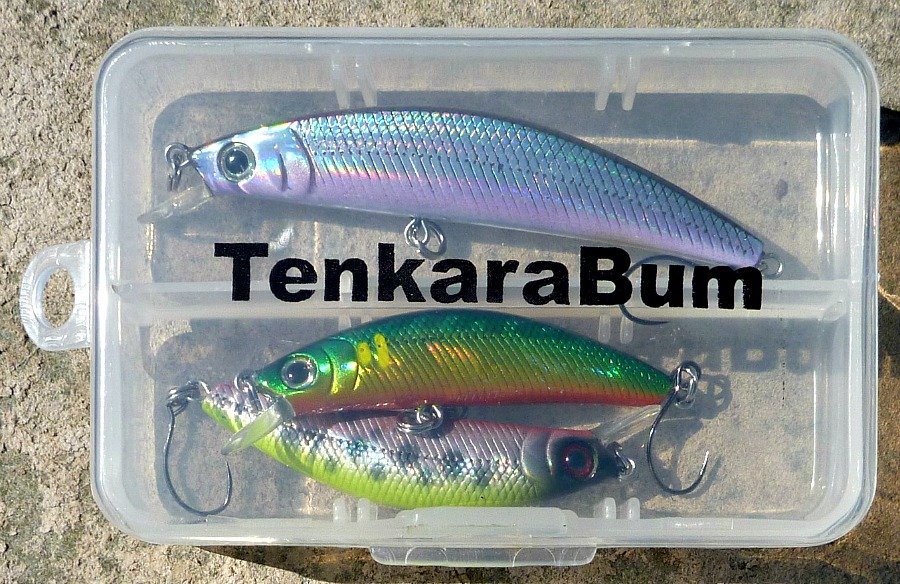 For plugs that come with two trebles, I remove the front and replace the rear.
For plugs that come with two trebles, I remove the front and replace the rear.The Japanese plugs designed for trout fishing in streams, like the minnow plugs shown above, are really quite effective. Unfortunately, nearly all come with two sets of treble hooks. I remove the front treble and replace the rear one with a single C'ultiva SBL-55M, size 8 or Daiwa Presso Multiplug size 8.
 Second split ring allows the use of a spinner hook on a plug.
Second split ring allows the use of a spinner hook on a plug.The replacement single barbless hooks for plugs are different than the
hooks for spoons. Replacement single hooks for spoons have horizontal
eyes. Replacement hooks for plugs have vertical eyes (ie, in the same plane as the hook bend). However, if you
add a second split ring, as seen in the photo above, you could use a replacement spoon hook on a plug.
The plugs draw strikes from some very impressive fish. Despite having only a single barbless hook rather than the two trebles, the plugs still hook and hold quite well.
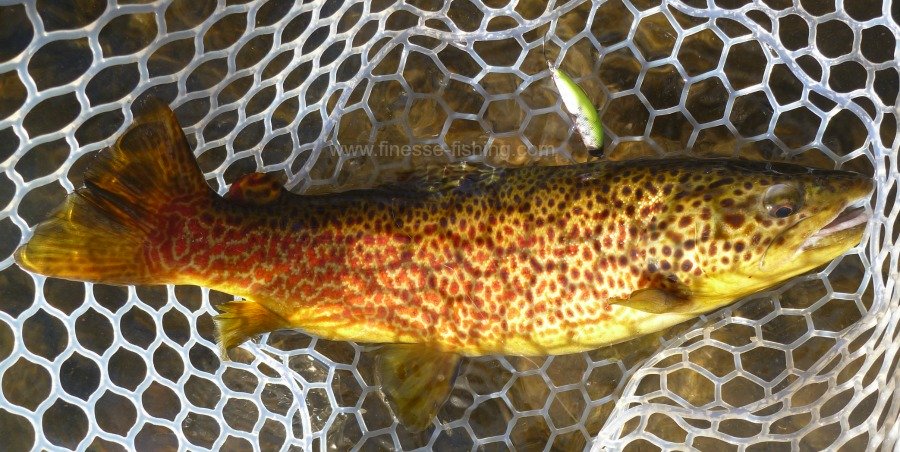 Once in the net, plugs with single barbless hooks often come out by themselves
Once in the net, plugs with single barbless hooks often come out by themselvesAs with the spoons, the plugs with the replacement single barbless hooks often will come out by themselves as soon as you get the fish into the net.
Replacing hooks on plugs is straightforward although it is not as easy as on spoons, and it is not always painless (even with split ring pliers). To me it is worth it though.
________________
* Although it would seem logical that a single hook lure causes less post-release mortality than a treble hook lure, the science does not support that view.
Most scientific studies are not freely available online. A few years ago, a paper entitled "The Truth About Hooks and Lures" was published in the New Jersey Fish and Wildlife Digest. Unfortunately the article is no longer available online. According to the article, the results are clear. Quoting from the article "The data is based on two major scientific papers which reviewed multiple studies; Taylor and White (1992, review of 18 hooking studies); and a review by Mongillo (1984). Both concluded that the number of hooks did not show a statistically significant relationship to hooking mortality"
However, there is a difference in hooking mortality based on the size of the fish. Single hooks resulted in increased mortality of larger fish, as they were more likely to take the lure deeper into the throat, increasing the chances of hooking the gills or being unable to unhook a lure lodged in the gullet. Treble hooks resulted in increased mortality of smaller fish, owing to the increased time out of the water necessary to remove multiple hook points from the smaller mouth.
Several times on these pages I have referenced the best spinner fisherman I know. He frequently catches larger fish and is adamant that one should not use single hook lures. He and many of people who follow his ideas and methods are absolutely convinced that single hook lures are more likely to hook fish in the gills or the gullet.
I recently watched a few YouTube videos by a guy who routinely catches trout that for anyone else would be the fish of a lifetime. Watching him unhook some of those huge fish makes it clear that a big fish can take even a large spinner with a treble hook further further into the mouth than you would expect. He bends down the barbs for easier, quicker unhooking.
I also recently watched a few YouTube videos by a guy who fishes primarily with a popular spinner on which he routinely bends down the barbs on the factory treble hook. With the barbs bent down, his spinner often comes out by itself when he gets the fish in the net, just as I have experienced with the spoons and spinners that have single barbless hooks. Still, I think I will continue to fish with single hooks. If you want to fish with treble hooks, bending down the barbs will make your life (and the fishes' lives) easier.
**By the way, the scientific studies reviewed in the article also conclude that there is no statistically significant difference between barbed and barbless hooks with respect to post-release mortality.
The conclusions are not what I would have expected. I guess you have to follow your conscience.
For me, that will mean single hooks - barbless unless I am on a stream where nearly all the fish are under 7", which I find to be almost impossible to keep on barbless hooks, and micro-barbed on those streams.
There is another reason for single barbless hooks, though. I doubt ultralight spin fishing for trout can ever achieve the cachet afforded to fly fishing, but to be accepted even as "almost-equals," spin fishermen will have to get rid of their barbed treble hooks. Even though the science doesn't support the need, this is clearly a situation where perception outweighs reality. Fly fishermen who fish barbless hooks and release all their fish will never accept the thought of fishing with barbed trebles. Perhaps you don't care what others think, and that is a perfectly valid stance. However, I do believe that replacing your barbed treble hooks with barbless singles will help elevate spin fishing for trout - and that will help everyone.
Finesse-Fishing Home > Single Hook Lures
Header photo: Tenryu Rayz RZ4102B-UL, Shimano Calcutta Conquest BFS-HG ('17)
Warning:
The hooks are sharp.
The coffee's hot.
The fish are slippery when wet.
Whatever you do, do it with finesse!
